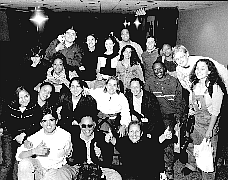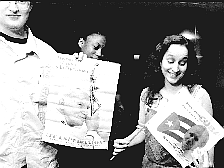|
|
Back from CubaFor 16 undergrads, an intersession trip was a once-in-a-lifetime happening
Joanne Cavanagh |

Johns Hopkins students visited Cuba to study the nation's history and ended up witnessing it.
On an exchange trip in January, 16 Hopkins undergraduates walked the crumbling yet regal streets of Havana during Pope John Paul II's first trip to Cuba, a once-officially atheistic nation ostracized by the anti-communist pontiff. The Cuba Exchange Program, which has sponsored two other undergraduate trips to the island nation, scheduled its intersession seminar this year to coincide with the pope's five-day visit.

Just off the plane at Baltimore-Washington International Airport, the happy Hopkins students give a thumbs-up to their experience in Cuba. Two days earlier, they had witnessed the pope's historical visit. |
"It was important for the students to be at the center of something like this. They were caught up in the emotion and enthusiasm of the visit," said Eduardo Gonzalez, professor of Spanish and film and media studies and director of Latin American Studies. "Cuba has been described as a non-Catholic country for several decades, but Cuba was significantly Catholic when we were there."
Some of the students got up at 4:30 a.m. and walked more than a mile to the Plaza of the Revolution to attend the pope's open mass on Sunday, Jan. 25. The plaza was already filling up for the service scheduled for 9 a.m. An estimated 200,000 listened to the pope's spiritual message and his denouncement of the excesses of both socialism and capitalism. The crowd glimpsed the pope and listened to the mass on loudspeakers around the black-topped plaza long reserved for Cuban Communist Party rallies.
Among those was Patrique Campbell, 21, a Hopkins senior majoring in international relations. Campbell, who is Christian but not Catholic, led a small group prayer in the morning before the mass. "For me, it was going there to get a message from God more than a historic event. It was an inspiration. The people gave the pope a lot of respect. And he wasn't like 'Yea, yea, I'm the pope, give me respect.' He said, 'Don't applaud me, give your praise to God.' It wasn't all about the pope, it was about Jesus."
A huge painting of Jesus was the pope's backdrop and to his right was a likeness of Ernesto "Che" Guevara, the Argentinian-born revolutionary who fought beside Castro and died a Cuban hero. The clash did not go unnoticed by Hopkins students discovering the nation's history and politics.

Along with an understanding of Cuba's history and culture, students brought back souvenirs of the pope's visit. |
"I came here with misconceptions, but now I know how multidimensional Cuba really is. It was incredible to see a country that has claimed to be atheistic sing and chant prayers. It's such a dichotomy to be in the Plaza of the Revolution singing 'Amen,'" said Anjali Kaur, 21, a senior also majoring in international relations. "It seemed to me that it was not just a religious feeling but more of a nationalistic one."
Of the country's 11 million residents, nearly 85 percent have said they are religious, and 40 percent claim to be Catholic, according to the Cuban Catholic Church. Fewer than 250,000 Cubans have gone to church regularly, church officials estimate. That is expected to change. The pope's personal visit should enliven the Catholic faith which, until the late 1980s, was outwardly oppressed by the Cuban government.
The papal visit also set the stage for a truce between Fidel Castro and John Paul II, two of the world's most controversial and tenacious political figures. During his visit, which included masses outside Havana, the pope criticized Cuba's human rights violations and condemned the 38-year-old U.S. trade embargo.
The 16 Hopkins undergraduates, all of whom speak Spanish, traveled to Cuba Jan. 14 to 27 to experience that pivotal moment and to explore the history and culture of tobacco and sugar, the island's primary crops. Under the 20-year-old Cuba Exchange Program, Hopkins professors, graduate students and most recently undergraduates have visited the island to conduct educational research. They've been granted licenses by the U.S. Department of the Treasury Office of Foreign Assets Control.
Though U.S. visas have sometimes been difficult to secure (and Cuban visa hurdles created in part by the pope's visit delayed, and nearly canceled, this last Hopkins student trip) luminary Cuban academics have visited the Hopkins campus to teach seminars. Miguel Barnet, an internationally known poet and vice president of the National Union of Cuban Writers and Artists, visited in early 1997.
During the trip, which cost about $1,400 per person plus spending money, Hopkins students absorbed the culture_a blend of leftover Soviet-style dogma, Caribbean island flare and a proud nationalism_that makes up Cuba.
"Unlike the United States, they seem to have an understanding as far as their African heritage is concerned and they take pride in that in their art, music and food," said Charles White, 21, a major in international relations, who said that this was his first trip out of the United States.
On weekday mornings in Havana, students awoke at the Havana Libre hotel (formerly the Havana Hilton) and walked a few blocks to the Fernando Ortiz Foundation, a Cuban non-governmental institution that hosts international academic exchanges. They attended morning seminars on the island's primary industries, and also visited a cigar factory, tobacco farm and two sugar mills.
"We got to see how these people make their living and how this has been part of their culture for hundreds of years," White said. "For them to preserve it the way they have is really wild to me."
The intersession seminar focused on the role of those industries in the nation's economy, history and environment. The lectures also explored the island's colonial history, popular African-based religions and Cuban folk music.
The Cuba Exchange Program began in 1979 between Hopkins' School of Advanced International Studies in Washington, D.C., and the University of Havana. Directors say it is the oldest such exchange program in the United States. In 1993, the program moved to the Homewood campus and is now based in the Latin American Studies Pro-gram. The Cuba Exchange Program is funded in part by the Ford Foundation, which also helped pay scholarships for some students who traveled during the intersession, directors said.
A few days after they arrived back in Baltimore, in the middle of the first week of classes, students gathered in each other's living rooms to relive the trip. "I miss Cuba," Campbell said. "I want to be there. It's nice and warm."
| GO TO FEBRUARY 2, 1998 TABLE OF CONTENTS. |
| GO TO THE GAZETTE HOMEPAGE. |